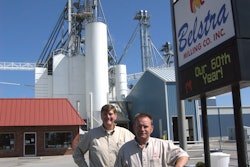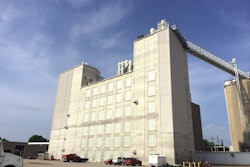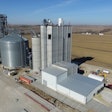Southwest of the Wichita Mountains, in the heart of cattle country and Tornado Alley, agribusiness firm Gavilon Grain LLC has staked its claim to export wheat market accessibility. The company, assembled from the acquisitions of ConAgra’s Peavey grain division and DeBruce Companies, holds claim to the No. 3 position for most grain storage in the United States. Just behind Cargill and ADM, Gavilon holds 300 million bushels of grain across 10 states and Mexico.
Now, building off this momentum, Gavilon Grain is expanding its operations through strategic greenfield developments in the Southwest.
In December 2009 construction began on the company’s Headrick, OK-based, 1.2-million-bushel slipform concrete elevator to handle hard red winter wheat produced within a 75-mile radius of the facility. In addition to the permanent structure, two ground storage piles offer a total of 4 million bushels of storage. The site, previously a wheat field, is located on a 110-car Burlington Northern Santa Fe (BNSF) shuttle loader on a 7,875 foot loop track.
“Gavilon saw an opportunity for a facility in this area,” site manager Mark Sethre explains. “As rail moves more toward shuttle programs running larger units, felt need/demand for larger units in this area. We’ve seen a lot of expansion and growth in grain business brought on by railroads and the world-wide demand for grains.”
Gavilon also owns and operates elevators in Wichita Falls, TX and Saganaw, TX. Grain leaving these facilities and the Headrick location is shipped to the Texas gulf — Houston and Galveston — for export to Egypt and Central America.
[List future operations]
Though the Headrick’s facility has the capacity to hold over 5 million bushels of wheat, unfortunately, its first full wheat harvest in operation will not be able to realize its full potential in 2011. Drought delivered the wheat harvest early in southwestern Oklahoma, severely impacting producer yields. Regardless, the company’s move into a new market has provided local producers with new marketing opportunities at a crucial time.
“As a mid-sized corporate farm, having an additional option aside in the area has been helpful, Gavilon offers us a better price for our product,” Gary Nason explains. Nason notes that with this season’s crippling drought, the 3,500 acre farm’s ability to utilize its on-farm storage and save the cost of working with a local coop allowed it the flexibility to sell to Gavilon, proving to be the silver lining in an otherwise dire situation. Drought sidebar on page ##.
The facility is projected to handle 10 to 12 million in a normal market year.
Happenings at new facility
Grain movement through the Headrick’s location is extremely streamlined, making the customer experience as fluid as possible. Vigen Construction served as millwright and general contractor for the facility, and Van Sickle Allen provided the architectural and engineering services.
Workflow begins at the west end of the site where producer trucks enter to approach the facility’s one Mettler Toledo scale in the grading area. An Intersystems probe takes a sample, and the wheat is fed through a MCi Kicker Grain Tester. All producers have a scan card that is swiped at the card reader and scanned into the Agris One-way System to generate a ticket for that load.
After the load is probed and sampled, the truck proceeds to the truck scale east of the probe shack, and the card is scanned again to record the truck’s pre-dump weight.
From there, the truck heads to the 900-bushel receiving pits and unloads the product. One of two Intersystems legs, a 40,000 bushel/hour or 20,000 bushel/hour bring the grain up into the elevator.
After it unloads, the truck alls back in line to the [which one] scale without stopping at the probe shack. The card is scanned again to capture the post-dump weight and a ticket is printed out for the driver.
“The card reader frees up the person in the grade shack,” Sethre explains. “This system gives the operator more time for the next customer since the previous driver can take of himself. The person running the probe doesn’t have to worry about it, the card takes care of it and eliminates the problem of making sure you’re weighing the right truck.”
Eight employees serve XXX local wheat producers.
Unique reclaim system
The Headrick’s facility features Gavilon’s first tripper reclaim system, one familiar to other industries, but unique to grain handling.
A McCord tripper system with a 1,200-foot-long belt has two arms that lay flat and a hopper fits over the end of the arm and a pay loader to dump the grain into the hopper and the arm brings it back on a long belt into the basement of the elevator onto the Hi-Roller reclaim belt and is elevated by the legs back into the bins. The tripper moves 15,000 bushels/hour.
Grain leaves out of elevator, hits belt, goes on tripper and dropped onto pile. When reclaiming it, tripper lies on the ground and is feed with a payloader, pulls it back in, hits belt and it goes back into elevator. The rail system on the tripper runs 1,350 ft. and permanently fixed into place — no need to move a portable conveyor around when building ground pile.
“The ground pile reclaim is much more efficient than loading on to the trucks and getting back to the elevator that way,” Sethre says. “The benefits have been a combination of time and dollar savings. I estimate we save about 4 cents/bushel.”


















